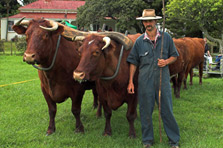Culture & History Whangarei
Legend has it that famed Polynesian navigator Kupe was the first person to see Whangarei Harbour’s dramatic headlands, while on his way back to Hawaiiki after discovering Aotearoa (New Zealand) around 950 AD.

Modern, science-based archaeological research has found settlement sites dating back to around the year 1200.
What is certain is that enough people arrived from eastern Polynesia to form viable communities that had similar social structures. Throughout the Whangarei district there remains evidence of these first settlers, often in the form of terracing for their fortified Pa (village) sites and piles of slowly eroding shells and charcoal deposits where they feasted on the region’s abundant shellfish.
By the 1700’s the land around Whangarei harbour was densely occupied by several sub-tribes of the Ngapuhi confederation, as confirmed by archaeological evidence on virtually every prominent hill overlooking the great harbour and its valleys. Whangarei was a popular waypoint for other tribes travelling north and south, with early missionary records indicating that as many as 3,000 canoe born travellers would camp and organise their travel on the shores of the harbour. These journeys were often social but could also involve warfare.
One of Europe’s famous son’s came within a few kilometres of this meeting place when in November 1769, Captain James Cook added the name Bream Bay to his Admiralty charts after his crew had enjoyed dining on freshly caught fish (Bream or Schnapper) a few cable lengths outside the harbour entrance.
One explanation for the harbour’s full name – Whangarei Terenga Paraoa - is “the swimming (gathering) place of whales” which can be further interpreted as “the meeting place of chiefs”. History tells of chiefs high in the hills calling up the whales, which were then stranded as the tide went out. The local people would make good use of the whales, using the bones, skin and oil. Even today pods of whales make seasonal visits well up into the harbour.
With the introduction of muskets in the late 1700’s and early 1800’s, warfare at this natural meeting place took a frightful toll and by the time of early European colonisation, the shores of the bountiful harbour were virtually deserted.
By 1845 there were 12 European families known to be living in the Whangarei area, but most of them moved back to the safety of Auckland when the Land Wars broke out following early misunderstanding of the 1840 Treaty of Waitangi. It wasn’t until the early 1870’s that a trading post re-emerged on the southern bank of the Hatea River in an area that today includes the popular international yachties’ haven known as the Whangarei Town Basin.

Meanwhile in the 1850’s and 60’s a hardy band of Scottish Presbyterians seeking a place to practice their religion in freedom, migrated via Nova Scotia and established a settlement in and around Waipu some 40 kms south of Whangarei Harbour. This has lead to the longest running annual Caledonian games in the world, held on New Year’s day every year.
In the late 1800’s Whangarei became bi-cultural with extensive settlement by both catholic and protestant families, mainly from Great Britain.
Today the district is a typical multi-cultural South Pacific society.
Whangarei museum live day '06
Further Information
More on early history
or ‘Whangarei the Founding Years’ by Nancy Pickmere





